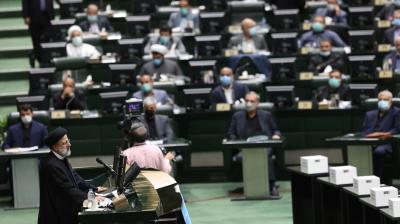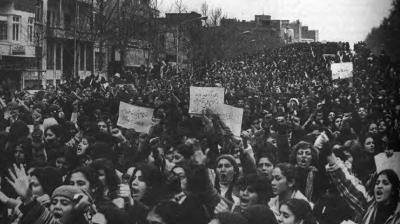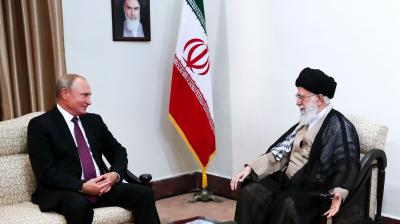Iran’s transition six months on: Repression meets resilience
By Hamidreza Azizi and Erwin van Veen
In September 2022, the death of Mahsa (Jina) Amini marked a major turning point for Iran. Her death sparked nationwide protests that rapidly evolved from calls to discard controversial hijab regulations to calls to overthrow the Islamic Republic. The government responded with repression, killing over 400 protesters in the course of late 2022 and early 2023, according to human rights groups.
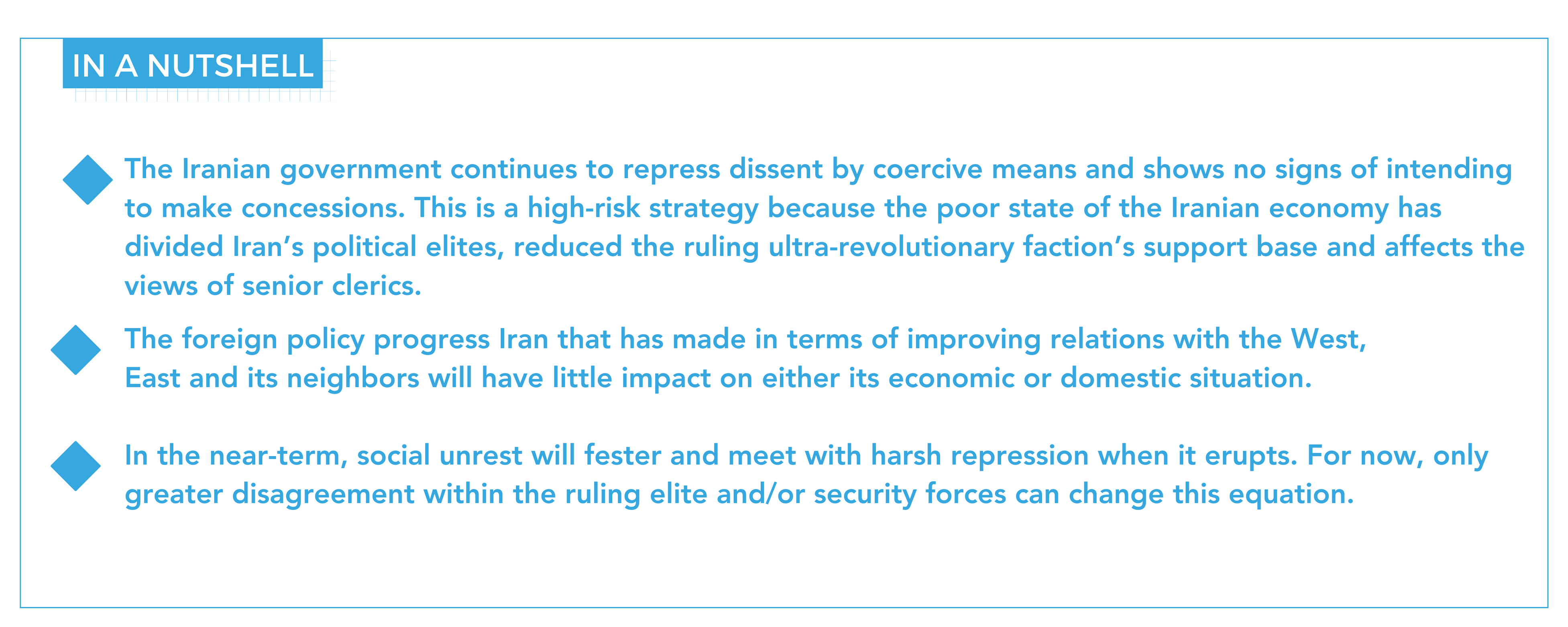
This eruption of public discontent and anger pointed once more to the accumulation of grievances in Iranian society during decades of clerical rule. It also exposed a widening chasm between the state and its citizens that will be difficult to repair without major changes in governance style and policies, which are not on the cards. In the background, bleak economic conditions threaten to alienate even staunch supporters of the government. To top it off, there has been mounting elite discord ever since the protests calmed down about how to respond to public demands.
Our blog series ‘Iran in transition’ explores power dynamics in four critical dimensions that shape the country’s direction: state-society relations, intra-elite dynamics, the economy, and foreign relations. This particular blog post analyzes key dynamics in these fields between March to September 2023, and seeks to decipher what they tell us about the direction of change in Iran.
State-society relations
Once protests calmed down in early 2023, a rapprochement seemed to be in the offing between an increasingly authoritarian state and an ever-resilient society. Notably, on 5 February, Ayatollah Ali Khamenei, Iran’s Supreme Leader, , decreed an “amnesty and reduced sentences” for many of those involved in the protests. Concurrently, official tolerance of women defying mandatory hijab norms in public spaces led to whispers about possible concessions.
These hints of conciliation were short-lived. The much-touted amnesty excluded protesters charged with more serious “crimes”, such as collaboration with foreign governments. Moreover, it came with strings attached: protesters arrested on the streets once more would be charged with even graver penalties. In another telling turn, the government introduced a draconian hijab law that mandates five to ten years imprisonment for women disregarding hijab regulations. Condemned by international bodies like the UN as “gender apartheid,” this law marks a clear intent to restore public authority on the basis of a conservative interpretation of Iran’s revolutionary ideology.
Many Iranians abstained from state-sanctioned events and even revered religious rituals.
Facing the first anniversary of Mahsa Amini’s tragic death, the government took no chances and dared protestors to repeat the events of 2022. It engaged in preventive suppression at scale, for example by intimidating the kin of protest victims and incarcerated protestors, as well as lawyers, journalists, and human rights advocates who defend protesters, or spotlight their plight. Yet, this clampdown triggered social defiance. Even though the country’s streets remained quiet, the population seethes. Iranian women, in particular, continue to challenge hijab regulation and ignore enhanced scrutiny as well as the risk of greater punishment. Digital spaces thrive as platforms of resistance: Iranians take to social media with vigor to document state transgressions and create new narratives of resistance. Many Iranians also abstained from state-sanctioned events and even revered religious rituals.
In short, the conflict between the ruling elite, manifested by the conservative hardline government, and the Iranian population has become a zero-sum situation that is more permanent and has sharper edges. As the government has been unable to fully reassert its authority and ran out of non-repressive means to do so, each day brings new risks of large-scale unrest and violence.
Intra-elite dynamics
The repercussions of the 2022/2023 protests did not limit themselves to the streets, but also permeated the backroom chambers of Iran’s political elites. This led to shifts in their relations. During the protests, there were already rumors of disagreements among Iran’s ruling elite on how to respond. For instance, Khamenei allegedly encouraged a harsher police response, while other senior leaders favored restraint. Nevertheless, such disagreements never manifested publicly.
But long-time proponents of reform, including opposition figures like Mohammad Khatami and Mir Hossein Mousavi, have increasingly voiced their desire for a radical shift in governance. Some even called for a change to a democratic regime. Moderates, such as those around ex-President Hassan Rouhani, initially remained silent. Yet, several weeks after the protests calmed down, they started to attack the government’s economic and social policies without, however, criticizing its handling of the protests. This can be viewed as an opening gambit to ‘return to politics’ in the near future.
The sword of Damocles that hangs over all intra-elite relations is the inevitable succession of Supreme Leader Khamenei who, at 84, is in the twilight of his tenure. The parliamentary elections of 2020 set the scene for the intra-elite power struggle that peaked with the 2021 presidential elections. As it happened, the Guardian Council – controlled by conservative ultra-revolutionaries - rejected the candidature of hundreds of moderate and reformist members of the Iranian elite. This scenario is likely to repeat in the run-up to the 2024 parliamentary elections, which may well prevent elites aligned with Hassan Rouhani and former Parliament Speaker Ali Larijani from returning to politics in force. Because the ruling hardline faction turned the usual single round of vetting of parliamentary candidates by the Guardian Council into a dual-layered process, they will have even more process control in 2024. Many Iranian politicians, including Larijani, have decried this stratagem as a “purification” tool that hardliners use to expand their own power position. In fact, Khamenei’s endorsement of the current parliament and the composition of President Raisi’s administration already signaled a consolidation of power in the hands of the ultra-revolutionary faction, i.e. hardline and highly conservative, at the cost of moderates and reformists.
In sum, at a time that popular trust in the hardline conservative elite ruling the Islamic Republic of Iran has dropped, as evidenced by large-scale and recurrent protests as well as a declining voter turn-out, the same elite is busy excluding other factions. By establishing full control over government, they expect to be able to shape the Iranian state in their image after the succession of Supreme Leader Khamenei. This indicates that the narrow space for accommodation of public demands – if it ever existed – will soon vanish entirely. It also suggests that future protests may be joined by alienated ‘opposition’ elites, however much the population dislikes them at the moment. They could nevertheless contribute organization, networks and leadership. Finally, the focus on maintaining power during transition implies that the hardline ruling faction will go to extreme repressive ends if necessary, somewhat akin to the Assad regime in 2011-2012.
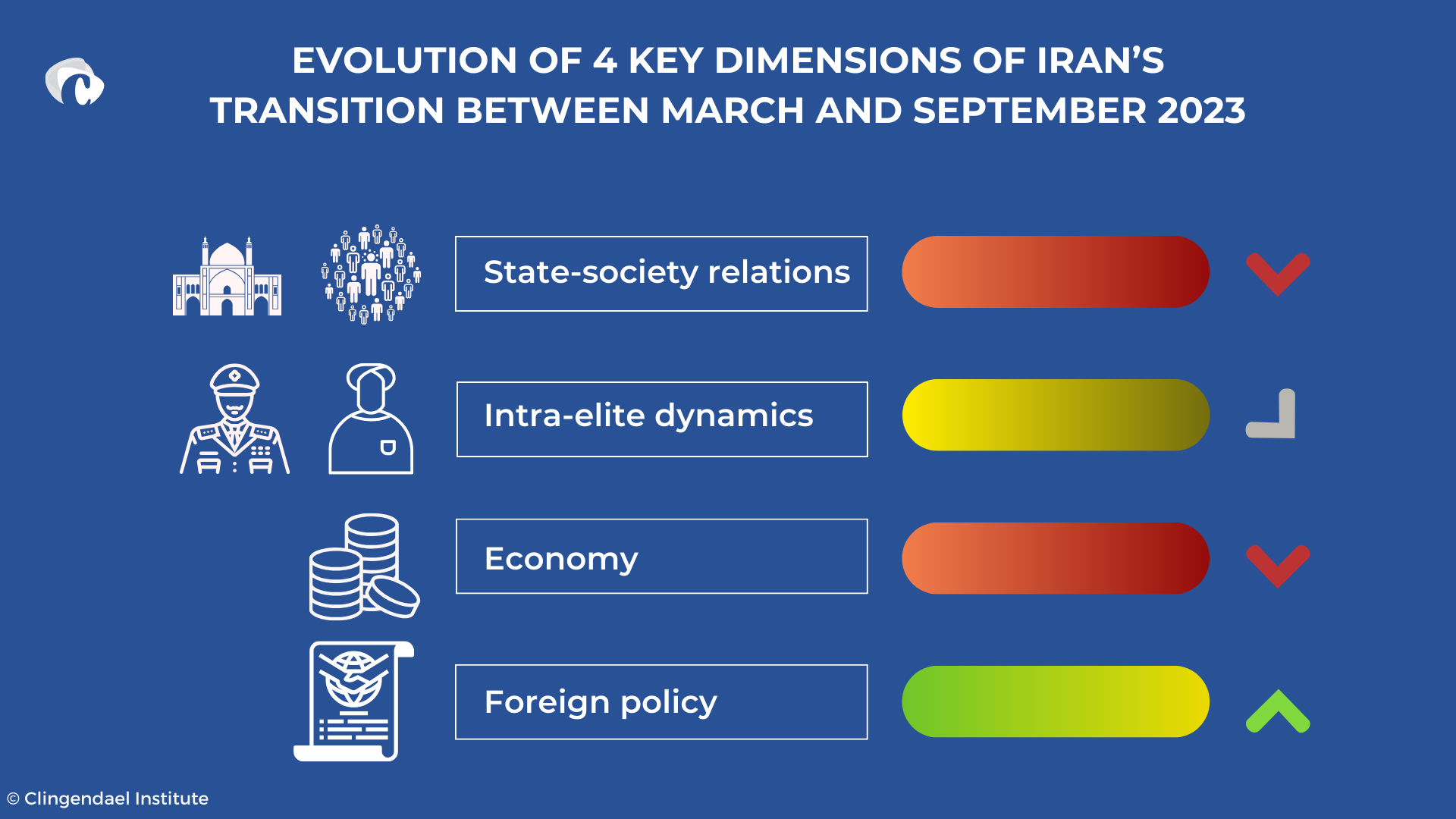
The economy
Today, Iran’s economic situation looks bleak. Poor economic management at home and punitive US sanctions have caused Iran’s economic health to deteriorate from bad to worse. Raisi’s tenure has seen the average annual inflation rate increase from 45.7% to 46.7% (August 2023). Even though this seems little, a deeper dive into the numbers reveals that consumer goods and food prices have grown by 107% and 151% respectively. This makes it more difficult for a growing number of Iranians to put food on the table and maintain basic amenities. Another indicator of economic trouble is that the poverty rate has increased from c. 19% to c. 30% of the population over the past decade, according to the parliamentary research center, with much of the increase concentrated in the past few years. Finally, the low level of Foreign Direct Investment, together with the inevitable difficulty of realizing Chinese and Russian investment on the basis of the Iran-China memorandum of understanding and a shared interest in the North-South Trade Corridor (NSTC) respectively, suggests that there is no foreign savior of the Iranian economy discernable either.
The fact that president Raisi’s tenure has been marked by quite a few reshuffles in pivotal economic roles points to an ongoing search for better managers of the economy, but also highlights profound disagreements on how to go about it. This management challenge has been complicated by the growing economic privileges and control of military institutions like the Quds Force of the IRGC, which sparks envy among other economic operators and makes the economy less dynamic.
High-ranking Shia clerics - pillars of the Islamic Republic - have started to voice their discontent with the government’s management of the economy as well.
Poor economic prospects cause a steady departure of talent and businesses from the country. Bahram Salavati, who runs the Iran Migration Observatory, paints a grim scenario. According to him, startups are relocating to Turkey and Arab countries on the Persian Gulf. Moreover, current migration is estimated to increase from 65,000 per year to more than 100,000. Alarmingly, a significant part of these migrants are well-educated: 53% of the country’s researchers, 45% of its medical staff and 40% of its students wish to leave the country if they can. This further worsens Iran’s economic prospects.
The same factors that encourage exit also impoverish lower-income groups with less mobility and internationally marketable skills, as well as entrepreneurs running local small and medium-sized enterprises. These groups are traditional support bases of Iran’s clerical establishment. In consequence, high-ranking Shia clerics - pillars of the Islamic Republic - have started to voice their discontent with the government’s management of the economy as well. Ayatollah Alavi Borujerdi’s recent remarks noted dire living conditions and acknowledged that they translate into popular discontent with the clergy. Similar concerns have been voiced by other senior clerics, including Ayatollah Makarem Shirazi, Ayatollah Alavi Gorgani, and Ayatollah Nouri Hamedani.
In brief, the mix of poor economic policies and international sanctions are degrading living conditions for many Iranians, encouraging brain-drain, triggering intra-elite strife about control of the commanding heights of the economy and eliciting discontent among the clerical establishment. In recognition of the seriousness of the situation, Supreme Leader Ayatollah Khamenei ranked the nation’s economic quandary as one of its critical vulnerabilities. But from the perspective of Iran’s ruling elites, the key problem is not necessarily rising poverty and inequality, but intra-elite and clerical discontent.
Foreign relations
This year marked several important shifts in Iran’s foreign relations, which can be broadly dissected into those with the West, the East, and the region. Regarding the West, relations deteriorated in early 2023 due to three factors. First, indirect JCPOA talks between the US and Iran reached a standstill while Tehran’s uranium enrichment hit rates of at least 60% (c. 80-90% is needed for nuclear weapons grade uranium). Second, Iranian arms deliveries to Russia in the Ukraine war further alienated it from the West. Third, European countries displayed unprecedented solidarity with Iranian protestors in the form of more sanctions on state-linked entities and officials. This introduced new complexity into the relationship.
By mid-2023, a partial thaw had set in. August saw Iran and the US achieving a diplomatic truce. Tehran agreed to release five wrongfully imprisoned Americans while Washington did the same with several incarcerated Iranians. Iran will also be granted access to approximately $6 billion in oil revenue with the limitation that these funds are to be used only for humanitarian use. They had been illegally (under international law) frozen in South Korea due to US sanctions. Meanwhile, Iran reportedly pledged not to target American interests in Iraq and Syria and marginally decreased its 60 percent enriched uranium stockpile. While a return to the 2015 JCPOA has become impractical due to Iran’s nuclear progress and the upcoming US presidential elections in 2024, a “political ceasefire” prevails for now.Regionally, Iran’s relations with Arab nations improved.
At the same time, Iran’s eastward diplomatic overtures also reaped dividends. In July, Tehran could celebrate full membership of the Shanghai Cooperation Organization (SCO) and, in a surprising twist, of the BRICS group in August. The Raisi administration naturally touts these moves as successes that signal Iran’s economic liberation from Western pressures. Yet, many observers warn that tangible economic improvement continues to hinge on mending ties with the West, given the vulnerability of most members of these fora to Western sanctions, as well as the variety of their affiliations with the West that range from hostile to semi-allied.
Regionally, Iran’s relations with Arab nations also improved. A China-brokered agreement saw Iran and Saudi Arabia take strides towards détente in March. Diplomatic ties with the UAE are on the mend, and there are signs of potential reconciliation with Egypt and Jordan. These shifts are driven by the win-win prospect of Iran receiving Arab investment, and Arab countries anticipating informal Iranian security guarantees in exchange. While useful for regional stability, realizing investment will be tricky and relations remain fragile. Actions will have to speak louder than words to achieve structural progress over the next few months.
On balance, Iran has successfully steered away from the risk of (in)direct military confrontation with the Saudi-UAE-Israel-US axis by weakening the commitment of both the Saudi’s and UAE, while giving the US just enough to remain at the sidelines. But the fundamentals remain unchanged: political relations with the West are tense and this will make it difficult for any regional schemes to bear economic fruits. Although the risk of a regional conflagration has been reduced, Iran’s foreign policy achievements will have limited positive impact on its economic or protest situation.
Transiting to where?
The Iranian government’s repressive response to the 2022/2023 protests stalled for a short moment once they had calmed down. This was largely due to intra-elite differences of view on how to proceed in a context of strong societal resistance and Western condemnation. After this short hiatus, repression resumed unabated and is signaling that Iran’s ruling elite keeps its eyes firmly on the upcoming succession of the Supreme Leader. They intend to stay in power without making significant concessions.
This is, however, a high risk strategy due to the poor state of the Iranian economy that has further divided Iran’s political elites, reduced the support base of the ruling elite and is starting to affect the views of senior clerics. While the ultra-revolutionaries established their political dominance during the 2020 parliamentary and 2021 presidential elections, they also have become more isolated at home and run out of excuses for poor governance performance.
Meanwhile, Iranian foreign policy has been rich in symbolic moves that make good headlines, but which bring little short-term investment or economic relief. Improving relations with the West, the US in particular, remains an important key to economic restoration and growth. The alternative pathway is to improve domestic management of the economy, but this requires addressing high levels of corruption and reducing the dominance of the IRGC’s industrial-military complex.
To conclude, social unrest will fester, waiting to erupt. When it does, it will be met with harsh repression. It is likely that only greater disagreements within the ruling elite and/or the security forces, which are closely linked, can alter this equation.






